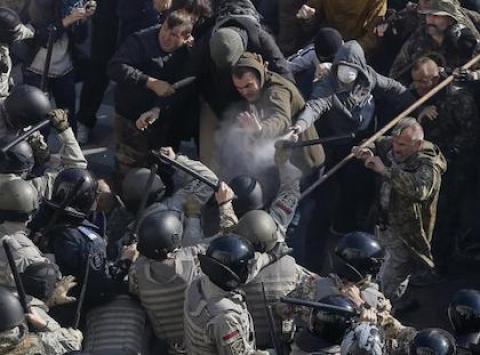Clashes erupted in the Ukrainian capital on Tuesday after nationalist protesters marched on parliament to demand that lawmakers officially recognize a controversial World War II-era guerilla movement.
Although organizers blamed provocateurs for stoking the violence and sullying what they said was a peaceful demonstration, the event nevertheless showcased how Ukraine’s fledgling government remains burdened by the legacy of the street protests that brought it to power.
On one hand, demonstrators have helped pressure lawmakers to adopt crucial reform legislation. Pro-democracy activists have hailed parliament’s creation on Tuesday of a national anti-corruption bureau.
But on the other, protests that turn violent are casting a pall over Ukraine’s uphill drive to democratize and providing fodder for Russia’s powerful propaganda machine.
“It’s a kind of revolutionary democracy with elements of anarchism,” says Vadim Karasyov, a Kyiv-based political analyst.
Tuesday’s demonstrations began after protesters from the nationalist Svoboda and Right Sector parties rallied outside parliament to lobby for official recognition of the Ukrainian Insurgent Army, a wartime resistance movement venerated by nationalists but vilified by pro-Russian Ukrainians for its temporary tactical alliance with Nazi Germany.
Some observers blamed radicals from a separate ultranationalist fringe group for deliberately inciting the violence after attempting to storm the legislature amid a hail of smoke bombs and flash-bangs.
Anton Gerashchenko, an advisor to Ukraine’s interior minister, said the “provocations” could have been the work of “foreign intelligence agencies of the Russian Federation.”
State-run media in Russia have consistently seized on any signs of instability in Ukraine to further the Kremlin’s narrative that a “fascist junta” took over after ex-President Viktor Yanukovych’s ouster last February.
The Ukrainian authorities, for their part, often see Russia’s own hand in that instability.
Gerashchenko said Tuesday’s violence ended with 50 arrests and injured more than a dozen police officers.
Whatever the case, it was only the latest in a lasting trend of street protests in Kyiv, where various pro-democracy, nationalist and other groups regularly rally downtown or in front of parliament — although almost always peacefully.
On Monday, hundreds of National Guard soldiers demonstrated outside the presidential administration calling for an end to an extended military draft that’s sent countless men to battle Russia-backed separatists in the east.
Officials and activists suggested that protest was also engineered by Russian intelligence services, the Kyiv Post reported.
In some ways, the regular demonstrations are sign of the times: the government is still a long way from building functioning political institutions, while the economy is still reeling from the effects of mismanagement and graft.
Meanwhile, the security forces have struggled to beat back pro-Russian insurgents in the east in a campaign many Ukrainians see as a fight for independence from Moscow’s domineering grasp.
That helps explain why the second-most popular group ahead of the October 26 parliamentary elections is a populist party headed by Oleh Lyashko, a firebrand nationalist who recently shot to fame for his vigilantism.
His group, appropriately named the Radical Party, is set to take around 12 percent of the vote, according to the most recent polls.
Widely criticized for his flagrant showmanship, Lyashko has still managed to cultivate a following by filming his abuse of corrupt officials and others deemed sympathetic to the rebel cause.
His antics appear to have encouraged an alarming wave of street justice in which protesters seize officials and forcibly dump them into industrial trash containers, allegedly for betraying public trust.
The most high profile victim of the so-called Trash Bucket Challenge was a former top Yanukovych ally, Nestor Shufrych, who was badly beaten in the southern Ukrainian city of Odessa earlier this month.
The dangers of such actions haven’t been lost on Ukrainian officials. Interior Minister Arsen Avakov condemned the trend shortly after that incident.
“Just a couple more broken faces like Shufrych’s… and Europe will turn away from our victorious revolution,” he wrote on his Facebook page earlier this month
Karasyov, the political analyst, says peaceful and violent demonstrations will probably continue as long as Ukraine’s political institutions remain feeble and the economy weak.
Civil society has matured in recent months, he says — evidenced by an outpouring of grassroots support for Ukraine’s underequipped army — but will still play a leading role on the streets.
“It will remain that way as long as the people are stronger than their rulers,” he says. “That comes with both pluses and minuses.”
[Dan Peleschuk is a GlobalPost Senior Correspondent based in Moscow. His work has been featured in such media outlets as The Christian Science Monitor, The Guardian Weekly, The National and the Voice of America, among others.]


Spread the word